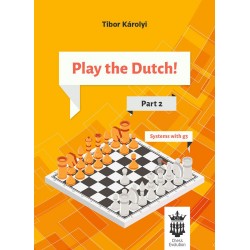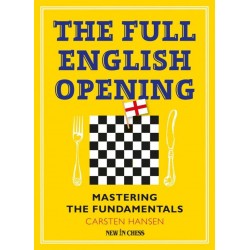No products
Catalog
New products
-

Pendrive "KING" 64GB (A-62/or)
Nice USB memory stick in the shape of a kingMaterial: wood /...
14,00 € -

1400 Chess Puzzless - Mating Combinations - R. Czajkowski, A. Nowicki (K-6254)
Introduction Chess is one of the most difficult and beautiful games man...
25,00 € -

Chessboard No. 6, plastic folding in 4, white and brown (S-212/br)
Tournament size chessboard No. 6 made of plastic, double folded to save...
8,95 € -

Chessboard No. 4, plastic folding in 4, white and brown (S-211)
Tournament size chessboard No. 4 made of plastic, double folded to save...
7,45 € -

Tournament chess ser No. 6 folding mahogany intarsia (S-16/M)
Professional chess set in tournament size No.6. Inlaid chessboard, with...
66,95 € -

Tournament chess ser No. 5 folding mahogany intarsia (S-12/M)
Professional chess set in tournament size No.5. Inlaid chessboard, with...
62,95 € -

Magnetic wooden chess MINI (S-140/M)
Wooden, magnetic perfect as a travel companion in MINI version (S-140/M)
25,45 € -

-

Wooden chessboard No. 5 / tournament standard (S-8/z)
Wooden chessboard Light beige/dark brown fields made by screen printing...
28,00 € -

Turbo-Charge your Tactics 1. Drive Your Improvement - V. Grabinsky, M. Oleksiyenko (K-6358/1)
Turbo-Charge Your Tactics 1 is essentially a chess puzzle book, but not...
26,36 € -

Turbo-Charge your Tactics 2. Accelerate and win - V. Grabinsky, M. Oleksiyenko (K-6358/2)
Turbo-Charge Your TacticsTurbo-Charge Your Tactics 2 concludes a...
26,36 € -

Chess Coach - Vladimir Barsky (K-6355)
A LIFE DEDICATED TO CHESS AND ITS PLAYERS This remarkable book is a...
29,95 €
-

Александр Никитин -С Каспаровым год за годом, ход за ходом (K-5727)
Как развить своеобразный талант...
11,08 € 13,85 €
Openings There are 238 products.
I. Sokolov & I. Salgado Lopez - The...
The Chigorin variation is one of the oldest weapons against the Ruy Lopez, first played at the Monte Carlo tournament 1902, by Carl Schlechter in his game versus Siegbert Tarrasch.
23,16 € 28,95 € -20%Reduced price!Tibor Karolyi - Play the Dutch: Part 2 -...
The Dutch defense is a highly popular opening nowadays with the idea to get a sharp and assymetrical position against 1.d4.
14,97 € 24,95 € -40%Reduced price!Tibor Karolyi - Play the Dutch: Part 1...
GM Mateusz Bartel - 4-times Polish Champion: "Are you bored with the classical or popular positions after 1.d4? Are the tonnes of theoretical lines overwhelming for you sometimes? Then you should try the Dutch Defence instead!
14,97 € 24,95 € -40%Reduced price!The killer Dutch - Simon Williams (K-3296/kd)
Grandmaster Simon Williams has played the Classical Dutch for over twenty years. It remains his favourite opening and has featured in some of his greatest individual results, including a win over World Championship finalist Boris Gelfand.
19,96 € 24,95 € -20%Reduced price!Christof Sielecki - Keep it Simple: 1.e4:...
Why is this opening repertoire called simple? For the simple reason that the variations are straightforward and easy to remember, and require little or no maintenance.
23,96 € 29,95 € -20%Reduced price!Kiril Georgiev, Semko Semkov - The Modern...
This book aims to arm White players adequately against Black’s most dangerous answer to 1.c4 - 1...e5. It is written from White’s standpoint and covers non-g3 set-ups. Some notable exceptions are 1.c4 e5 2.Nc3 d6 3.g3, although 3.Nf3 and 3.d4 is also analysed.
17,56 € 21,95 € -20%Reduced price!Kiril Georgiev, Semko Semkov - The Modern...
This volume completes the coverage of the Modern English with a repertoire against 1...c5, 1...Nf6, and 1...e6. It is based on active fight for the centre by e3 and d4. It is written from White’s standpoint, but it should also serve Black players since the authors often discuss several alternatives to the main lines. The book follows the acclaimed Chess...
17,56 € 21,95 € -20%Reduced price!Michael Roiz - The Queen's Indian Defence...
The Queen’s Indian Defence is one of the most reliable defences against 1.d4, and features in the repertoires of many of the world’s top players. Black develops with a solid pawn structure and uses his pieces to put dynamic pressure on White’s pawn centre.
18,80 € 23,50 € -20%Reduced price!Unknown Weapons in the Grünfeld by Milos...
The Grünfeld Defence is one of the most dynamic openings for Black. This opening was developed by two famous World Cham-pions, namely Bobby Fischer and Garry Kasparov. While the theory is still far from being ex-hausted and still developing our author Grandmaster Milos Pavlovic made a strong case and found new alternatives to battle White’s setups. This...
13,77 € 22,95 € -40%Reduced price!Play 1.d4 d5 2.c4 e6! - Alexei Kornev...
A Black repertoire based on the QGD. All the opening variations for Black have been chosen according to the latest fashion in the games of the top-class grandmasters. For example, after the moves 1.d4 d5 2.c4 e6 3.Nc3 Nf6 4.cxd5, Kornev analyses a line which has been played often in the last several years by Vladimir Kramnik - 4..Nxd5, with which Black...
17,56 € 21,95 € -20%Reduced price!The Full English Opening. Mastering The...
The first one-volume book that covers all variations The English Opening (1.c4) is a popular choice at both club and master level, because it is a chess opening that suits all styles. Elite players as diverse as Magnus Carlsen, Fabiano Caruana and Vishy Anand include it in their repertoire. As White you can play aggressively or opt for a more strategic...
22,36 € 27,95 € -20%Reduced price!The Exchange Queen's Gambit for Black by...
The Queen's Gambit is one of the oldest and most reliable opening which is mainly based on positional and structural understanding.
14,97 € 24,95 € -40%Reduced price!Fighting Chess with Black by Yelena Dembo...
Two great books for players who play the Sicilian Defence and King’s Indian Defence in one volume. Fighting the anti-King’s Indian by Yelena Dembo Fighting the anti-Sicilians by Richard Palliser 'I love playing the King's Indian, but no-one ever allows me to reach my favourite opening!' Does this sound like an all too familiar complaint?
18,36 € 22,95 € -20%Reduced price!Opening Repertoire: 1 e4 by Cyrus...
Everything you need to know to open 1 e4 with confidence Solid, reliable systems that do not require a mass of memorisation Written by one of the world’s leading chess authors
19,16 € 23,95 € -20%Reduced price!A Complete Guide to the Modern / Pirc...
Everyman Chess's Starting Out series has firmly established itself as the leading guide to studying openings for up-and-coming players. These books are distinguished by their easy-to-read layout, the lucid explanations of the fundamentals, and the abundance of notes, tips and warnings to help the reader absorb vital ideas. Now brought together in one...
17,56 € 21,95 € -20%Reduced price!Bologan`s Caro-Kann: A Modern Repertoire...
The Caro-Kann is one of the most important and popular responses to 1.e4. World champions Botvinnik, Petrosian, Karpov and Anand have played this reliable chess opening in many of their games. Present-day elite players such as Hikaru Nakamura and Fabiano Caruana are proving that the ‘drawish’ reputation of the Caro-Kann no longer holds in modern chess.
23,16 € 28,95 € -20%Reduced price!Jaan Ehlvest - Grandmaster Opening...
There are hundreds of opening books available, full of deep analysis, but many of them fail to explain the reasons for choosing one computer line over another. And how top players distinguish between good and bad opening lines remains a mystery to most of the chess world.
20,79 € 25,99 € -20%Reduced price!John Shaw - Playing 1.e4 - Sicilian Main...
In this, the last of three volumes on 1.e4, GM John Shaw completes his state-of-the-art White repertoire by tackling the biggest challenge of all: the main lines of the Sicilian Defence.
18,00 € 22,50 € -20%Reduced price!John Shaw - Playing 1.e4 - French Defence...
Developing an effective repertoire with 1.e4 requires extensive research, mixed with fine judgement and a good deal of creativity. In this, the second of three volumes, GM John Shaw turns the analytical spotlight on the French Defence, advocating his own favourite weapon for White, the Tarrasch Variation. The final part of the book begins the mammoth task...
18,00 € 22,50 € -20%Reduced price!How Ulf Beats Black: Ulf Andersson's...
In his prime, in the 1970-s and 80-s, legendary Swedish chess grandmaster Ulf Andersson was a Top 10 player with a distinct, immediately recognizable style. He almost never lost a game and kept scoring wins from quiet positions.
22,36 € 27,95 € -20%Reduced price!Winning in the Chess Opening: 700 Ways to...
Every chess player loves to win early in the opening. However you should never lose sight of the most important objective of your opening play: the proper development of your pawns and pieces.
18,36 € 22,95 € -20%Reduced price!




























